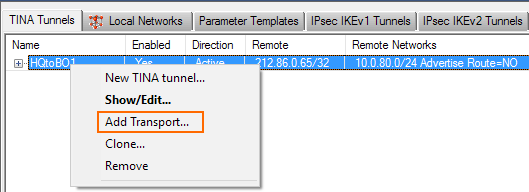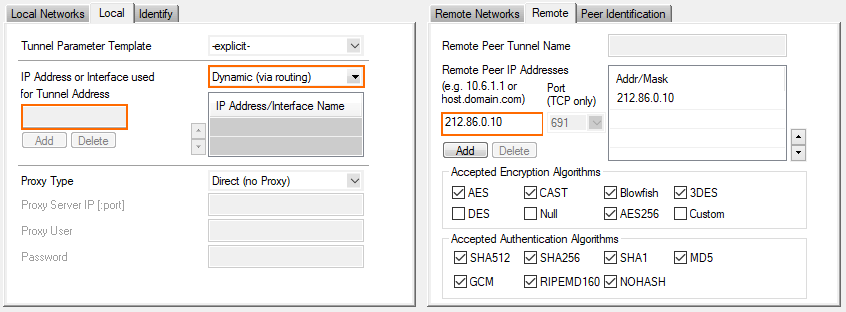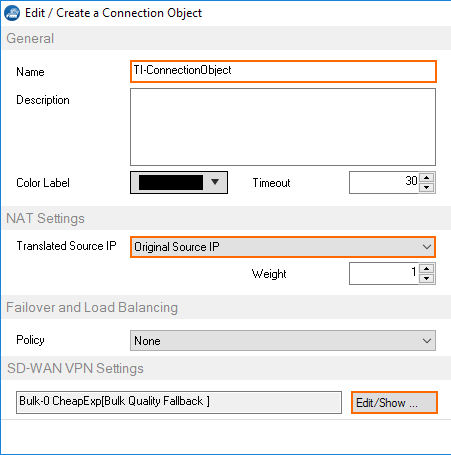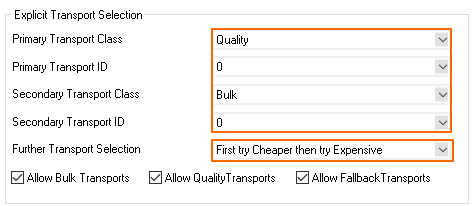Add multiple VPN transports to your TINA site-to-site VPN tunnel to use SD-WAN. The SD-WAN settings in the access rules matching the traffic determine which transport is used.
Before You Begin
Create a TINA site-to-site VPN tunnel between two CloudGen Firewalls. For more information, see How to Create a TINA VPN Tunnel between CloudGen Firewalls.
Step 1. Add a Transport to the VPN Tunnel
- Go to CONFIGURATION > Configuration Tree > Box > Assigned Services > VPN Service > Site to Site.
- Click Lock.
- Right-click an existing TINA VPN tunnel and select Add Transport. The TINA Tunnel window opens.

- (IPv6 only) Select the IPv6 check box. IPv6 is supported only for the VPN envelope.
- Configure the Basic TINA tunnel settings. For more information, see TINA Tunnel Settings.
- Transport – Select the transport encapsulation: UDP (recommended), TCP, TCP&UDP, ESP, or Routing.
- Encryption – Select the encryption algorithm: AES, AES256, 3DES, CAST, Blowfish, DES, or Null.
- Authentication – Select the hashing algorithm: MD5, SHA, SHA256, SHA512, NOHASH, RIPEMD160, or GCM.
- SD-WAN Classification – Select the SD-WAN classification.
- SD-WAN-ID – Select the SD-WAN ID. Each SD-WAN class/ID combination can be used only once.
- Compression – Select Packet or Stream compression. Do not use in combination with WAN Optimization.

In the Direction tab, select the Call Direction from the drop-down list. At least one of the firewalls must be active.
- Click the Local tab, and configure the IP address or Interface used for Tunnel Address:
- (IPv4 only) First Server IP – First IP address of the virtual server the VPN service is running on.
- (IPv4 only) Second Server IP – Second IP address of the virtual server the VPN service is running on.
- Dynamic (via routing) – The firewall uses a routing table lookup to determine the IP address.
- Explicit List (ordered) – Enter one or more explicit IP addresses. Multiple IP addresses are tried in the listed order.
- In the Remote tab, enter either one or more IPv4 or IPv6 addresses or an FQDN as the Remote Peer IP Addresses, and click Add.

- In the Remote tab, select the Accepted Algorithms. The list of accepted ciphers must contain the cipher selected in the previously configured Encryption settings.
- (optional) Click the Identity tab and configure the Identification Type and Server Protocol Key for this transport. By default, the Identity settings of the TINA tunnel is used.
- Click OK.
- Click Send Changes and Activate.
Step 2. Add the VPN Transport on the Remote Firewall
Duplicate the VPN transport configuration on the remote firewall. At least one firewall must be configured to use an active call direction.
Step 3. Create a Custom Connection Object for the SD-WAN Primary
Create a custom connection object to route traffic into the new VPN transport and configure the firewall as a SD-WAN primary.
- Go to CONFIGURATION > Configuration Tree > Box > Assigned Services > Firewall > Forwarding Rules .
- In the left menu, click Connections.
- Right-click the table and select New Connection. The Edit/Create a Connection Object window opens.
- Enter a Name.
- From the Translated Source IP list, select Original Source IP.
- Click Edit/Show. The SD-WAN Settings window opens.

- From the Transport Selection Policy drop-down list, select Explicit Transport Selection.
- From the SD-WAN Learning Policy drop-down list, select Primary (Propagated SD-WAN settings to partner).

- Configure the Explicit SD-WAN Transport Selection policy:
- Primary Transport Class – Select the default transport class for the traffic matching this rule.
- Primary Transport ID – Select the default transport ID for the traffic matching this rule.
- Secondary Transport Class – Select the backup transport class.
- Secondary Transport ID – Select the backup transport ID.
- Further Transport Selection – Select the transports that are used if the primary and secondary VPN transports fail. Depending on the additional available VPN transports, you can define more than one backup path. Select from the following predefined policies:
- First try Cheaper then try Expensive
- Only try Cheaper
- First try Expensive then try Cheaper
- Only try Expensive
Stay on Transport (no further tries)
- Allow Bulk Transports | Allow Quality Transports | Allow Fallback Transports – Enable all transport classes that can be used as a backup path in combination with the Further Transport Selection setting.

- (TCP transports only) Configure TCP Transport Traffic Prioritization settings:
- When using BULK Transports – The priority level for the bulk transport class.
- When using QUALITY Transports – The priority level for the quality transport class.
- (Dynamic Mesh only) Configure the Dynamic Mesh settings. For more information, see Dynamic Mesh VPN Networks.
- Click OK.
- Click OK.
- Click Send Changes and Activate.
Step 4. Create a Custom Connection Object for the SD-WAN Secondary
Create a custom connection object to route traffic into the new VPN transport and configure the firewall as a SD-WAN secondary.
- Go to CONFIGURATION > Configuration Tree > Box > Assigned Services > Firewall > Forwarding Rules .
- In the left menu, click Connections.
- Right-click the table and select New Connection. The Edit/Create a Connection Object window opens.
- Enter a Name.
- From the Translated Source IP list, select Original Source IP.
- Click Edit/Show. The SD-WAN Settings window opens.

- From the SD-WAN Learning Policy drop-down list, select Secondary. All other SD-WAN settings are learned from the SD-WAN primary.

- Click OK.
- Click OK.
- Click Send Changes and Activate.
Step 3. Edit Access Rules Matching the VPN Traffic
Edit the access rules matching the VPN traffic on both firewalls to use the custom connection objects. If multiple firewalls are connected in a hub and spoke VPN network, the firewall acting as the VPN hub must be the SD-WAN primary. Create multiple access rules and connection objects to statically route VPN traffic through different VPN transports.
For more information, see How to Create Access Rules for Site-to-Site VPN Access.
Next Steps
Configure advanced SD-WAN features such as:
